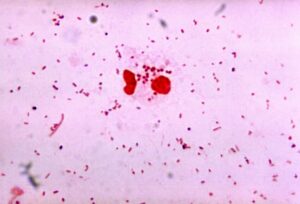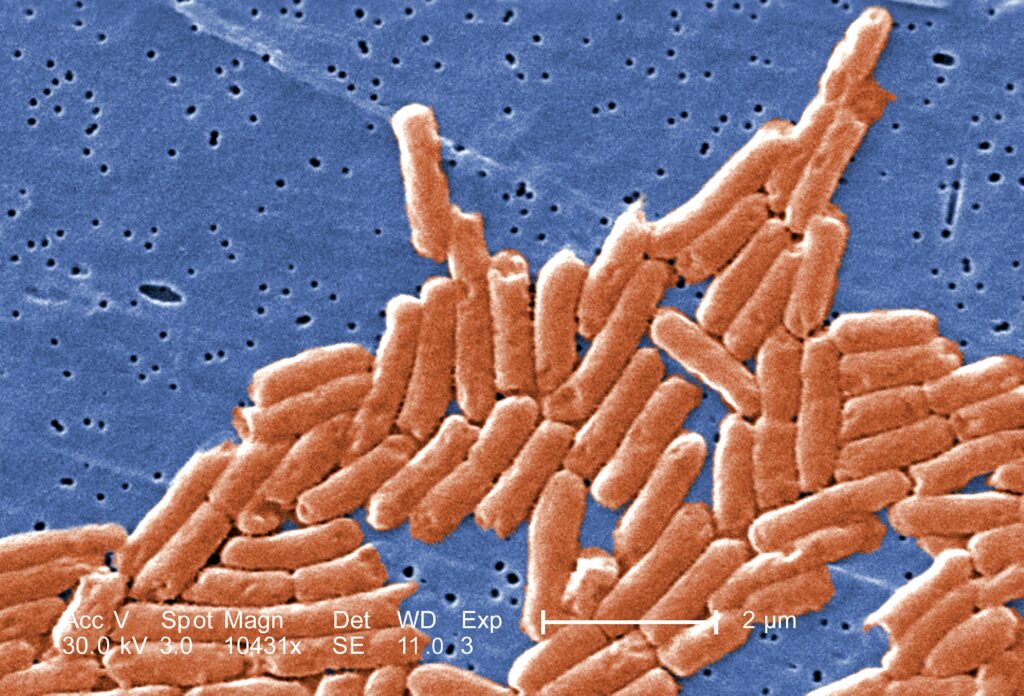The gram negative bacteria contain a thin peptidoglycan layer and cannot retain crystal violet stain which is used in gram staining method.
The gram negative bacteria contain a very low amount of peptidoglycan in the cell wall and appears pink colour in gram staining. In this section we shall discuss gram negative bacteria examples.
The gram negative bacteria is found almost in every environment on the earth that can support life. These are more resistant to antibiotics than the gram positive bacteria.
Examples Of Gram Negative bacteria:
Gram negative Cocci bacteria:

Public Domain Images
Gram negative bacilli bacteria:

Public Domain Images
Gram negative Spiral bacteria:
Gram negative Vibrio bacteria:
Characteristics of gram negative bacteria:

Classification of gram negative bacteria:
The gram negative bacteria are classified basing oh the morphology,( Phenotypic), Analytical characterisation and Genotypic characteriasation. The morphology classification is also known as phenotypic characterisation. It includes growth requirements, and biochemical requirements(Bio typing), serotype, antibiotic resistance patterns (MSSA Vs MRSA), size, shape and staining procedure.
Phenotypic Characterization:
In phenotypic characterization the bacteria can be classified basing on the technique like serotyping and bio typing.
Bio typing is the process of classification of bacteria in the absence of specific enzymes like lipases, proteases, nucleases.
Serotyping is the process of classification of bacteria basing on the antigen present in their cell membrane by using specific antibodies. Serotyping is the one of the latest tools that are used for bacterial characterization.
Analytical characterization:
This is a big process and requires special equipment.
Usually this is performed in special laboratories.
The analytical characterisation Includes Whole cell lipid analysis, cell wall fatty acid analysis, Whole cell protein analysis, enzymes and electrophoresis.
The whole cell protein analysis is performed by using mass spectroscopy.
Genotypic Characterization:
In genotypic characterisation bacterial DNA is used for classification.
Earlier scientist used to identify Guanine and Cytosine ratio (G-C ration).
Now a day’s scientist are also using DNA – DNA hybridisation.
Nucleic acid sequence analysis is also one of the most useful method now a days.
In nucleic acid sequence analysis the known sequence is used for identification of unknown sequence.
The growth of gram negative can be prevented by subjecting them to antibiotics.
Read More on :Do Bacteria Have DNA : Why, How And Detailed Insights
Frequently Asked Questions:
What is the difference between gram positive and gram negative bacteria?
The gram positive bacteria contain a thick peptidoglycan layer where as it is thin in gram negative bacteria.
The gram positive bacteria contain a thick peptidoglycan layer and appears violet in color in gram staining and gram negative bacteria contain thin peptidoglycan layer and appears pink in color.
Does E.Coli come under gram negative bacteria?
E.coli comes under gram negative bacteria and it causes urinary tract infections in humans.
What are the common diseases caused by gram negative bacteria in humans?
Cholera, Plague, Typhoid fever, Meningitis and Urinary tract infection are common bacterial diseases in humans.
Why are gram negative bacteria more harmful than gram positive bacteria?
The gram negative bacterial cell wall is hard and it does not susceptible to antibiotics easily and can release endotoxins when they are subjected to antibiotics.
What are the secretion system in gram negative bacteria?
The gram negative bacteria have broad enclosed secretion system to shift tiny molecules, DNA, Amino acids, Proteins.
What is meant by gram negative blood stream infection?
The blood stream infection means the attack of blood by the microorganisms like bacteria. In this case the bacteria are resistant to antibiotics and might cause fever. Some times the blood stream infection is relieved with out any treatment.
Also Read:
- Digestive enzymes in lysosomes
- Ectoparasite examples
- Molecules active transport examples
- Adenine function in rna
- Brain anatomy
- Channel proteins passive transport
- Horseshoe crab characteristics
- Simple fruit example
- Chromosome function in cell
- Eyelid anatomy

Hi…I am Nagasrilakshmi Narne, a postgraduate in Biotechnology and English. also completed my B.Ed. I worked in Vimtalabs as a project trainee and I have work experience as a faculty of English. So I can explain topics in simple language.
Let’s connect through LinkedIn